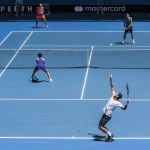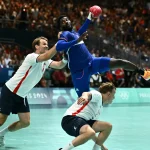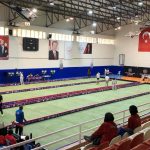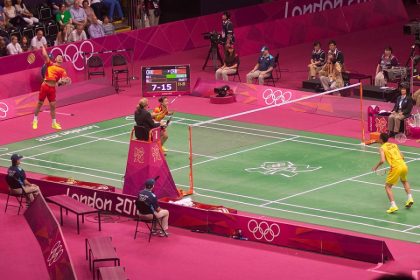Why is Golf Popular in the Global Sports Market?
Golf’s popularity in the global sports market, valued at USD 12.03 billion in 2023 with a projected CAGR of 5.6% through 2032, stems from several factors:
- Global Reach and Accessibility:
- Golf is played in over 200 countries, with 33,161 courses worldwide (42% in the U.S., 13% in Europe, 13% in Asia). Its availability in urban and resort settings attracts diverse demographics.
- Public courses and driving ranges make it accessible to beginners, while private clubs cater to elites, broadening its appeal.
- Olympic and Media Exposure:
- Golf’s return to the Olympics in 2016 and 2020 (Tokyo) and inclusion in Paris 2024 increased its global visibility, drawing younger audiences and sponsorships from brands like Nike and Rolex.
- Televised events, such as The Masters and PGA Championship, garner millions of viewers, with streaming platforms amplifying reach.
- Economic Impact and Sponsorship:
- The golf industry supports 2 million jobs and generates USD 102 billion annually in the U.S. alone. High-profile endorsements and prize purses (e.g., USD 20 million for The Players Championship) attract top talent and corporate investment.
- The rise of LIV Golf, backed by Saudi Arabia’s Public Investment Fund, has disrupted traditional tours, offering massive contracts (e.g., USD 125 million to Dustin Johnson), further elevating the sport’s profile.
- Health and Lifestyle Appeal:
- Golf promotes physical activity (walking 5–7 km per round) and mental well-being, appealing to aging populations and those seeking low-impact exercise. Its outdoor setting aligns with post-COVID demand for open-air recreation.
- The sport’s social nature fosters networking, making it popular among business professionals and retirees.
- Youth and Diversity Growth:
- Programs like First Tee and Drive, Chip and Putt engage young players, with 3.2 million U.S. juniors playing in 2023. Initiatives to diversify the sport, led by figures like Tiger Woods, have increased participation among women (26% of players) and minorities.
- Technological Advancements:
- Innovations like golf simulators, launch monitors, and apps (e.g., TrackMan, Arccos) enhance training and engagement, appealing to tech-savvy audiences. Virtual golf, including Topgolf, attracts non-traditional players.
Important Global Events
Key international golf events include:
- The Majors (Men):
- The Masters (Augusta, USA): April, iconic for its green jacket and USD 18 million purse.
- PGA Championship (USA): May, featuring top professionals, with a USD 17.5 million purse.
- U.S. Open (USA): June, known for challenging courses, offering USD 20 million.
- The Open Championship (UK): July, the oldest major, played on links courses, with USD 16.5 million.
- The Majors (Women):
- U.S. Women’s Open: June, with a USD 12 million purse, the largest in women’s golf.
- Women’s PGA Championship: June, offering USD 10 million.
- The Evian Championship (France): July, USD 6.5 million.
- Women’s British Open: August, USD 9 million.
- Chevron Championship: April, USD 5.2 million.
- Olympic Games:
- Golf was featured in Tokyo 2020 and Paris 2024 (60 players per gender), with events planned for Los Angeles 2028. It showcases top players like Scottie Scheffler and Nelly Korda.
- Ryder Cup:
- A biennial team event (USA vs. Europe) held in odd-numbered years (e.g., 2025 at Bethpage, USA), known for intense competition and no prize money, emphasizing prestige.
- Presidents Cup:
- A biennial USA vs. International (non-European) team event in even-numbered years, with the 2024 event in Montreal, Canada.
- DP World Tour and LIV Golf:
- The DP World Tour hosts global events like the Dubai Desert Classic, while LIV Golf’s 14-event series in 2025 (e.g., Singapore, Saudi Arabia) offers USD 25 million per event.
- Amateur and Junior Events:
- U.S. Amateur Championship: A pathway to professional tours.
- NCAA Golf Championships: For college athletes.
- World Amateur Team Championships: Held biennially, promoting global talent.
How to Get Started and Become a Great Golf Athlete
Getting Started (Young or Old)
- Access Facilities:
- Visit a local driving range, public golf course, or golf simulator to try the sport. Many facilities offer affordable rentals for clubs and beginner clinics.
- Programs like First Tee (for ages 7–18) provide low-cost access and coaching in the U.S. and globally.
- Learn the Basics:
- Take lessons from a PGA or LPGA professional to master grip, stance, swing, and putting. Group clinics are cost-effective for beginners.
- Understand golf etiquette (e.g., pace of play, divot repair) and basic rules (e.g., stroke play, match play).
- Acquire Equipment:
- Start with a beginner set (driver, irons, putter, wedges) or rent clubs. Used sets cost USD 200–500, while junior sets are cheaper.
- Essential gear includes golf balls, tees, a glove, and proper attire (collared shirt, non-denim pants for most courses).
- Practice Regularly:
- Practice at driving ranges to build swing consistency and short-game skills (chipping, putting). Aim for 1–2 sessions per week.
- Play 9-hole courses to gain on-course experience without committing to a full 18 holes.
- Join Local Programs:
- Enroll in junior leagues, school teams, or adult amateur events. Organizations like the USGA and R&A host beginner-friendly competitions.
- Social golf apps (e.g., GolfNow) connect players for casual rounds.
Becoming a Great Athlete
- Physical Training:
- Strength and Flexibility: Elite golfers train core strength, rotational power, and mobility. Exercises include medicine ball throws, deadlifts, and yoga. Tiger Woods emphasizes leg strength for driving distance.
- Endurance: Walking 18 holes (5–7 km) requires cardiovascular fitness. Pros train with interval running or cycling.
- Nutrition: Consume 50–60% carbohydrates, 20–25% protein, and 15–25% fats. Hydration (2–3 liters daily) and pre-round meals (e.g., oatmeal, bananas) optimize performance. Young athletes need 2,500–3,500 kcal/day to support growth.
- Technical Skills:
- Swing Mechanics: Work with a coach to refine driver, iron, and wedge swings. TrackMan or FlightScope analyzers provide data on ball flight and spin.
- Short Game: Dedicate 50% of practice to putting and chipping, as 60–65% of strokes occur within 100 yards. Pros like Rory McIlroy excel here.
- Course Management: Learn to read greens, assess wind, and choose clubs strategically. Study course layouts before tournaments.
- Mental Preparation:
- Develop focus and resilience, as golf is 90% mental. Techniques like visualization, breathing exercises, and pre-shot routines (e.g., Scottie Scheffler’s routine) reduce pressure.
- Work with sports psychologists to manage emotions after bad shots. Books like Golf is Not a Game of Perfect by Bob Rotella are widely recommended.
- Competitive Progression:
- Amateur Level: Compete in local, state, and national amateur events (e.g., U.S. Junior Amateur). Success here can lead to college scholarships or AJGA invitations.
- College Golf: Join NCAA programs (e.g., Stanford, Texas) for high-level coaching and exposure. Many pros, like Collin Morikawa, emerge from college.
- Professional Tours: Earn status on mini-tours (e.g., Korn Ferry Tour) or qualify for PGA/LPGA Tours via Q-School. LIV Golf offers alternative pathways.
- Global Events: Aim for majors or Olympic qualification through world rankings (OWGR for men, Rolex Rankings for women).
- Coaching and Technology:
- Hire a coach with PGA/LPGA certification or tour experience. Coaches like Sean Foley (Tiger Woods) focus on biomechanics.
- Use tech like Arccos for shot tracking or Full Swing simulators for year-round practice. Video analysis refines swing flaws.
- Injury Prevention and Recovery:
- Common injuries include lower back pain (from rotation) and wrist strains. Warm-ups, stretching, and core stability reduce risks.
- Rest and physiotherapy are key. Older athletes should prioritize mobility work (e.g., Pilates) to maintain swing speed.
Considerations for Young vs. Old Athletes
- Young Athletes (Under 18):
- Start early (ages 6–10) to build fundamentals. Junior programs like AJGA and First Tee offer coaching and tournaments.
- Focus on fun to avoid burnout. Limit practice to 10–15 hours/week, balancing school and play.
- Compete in Drive, Chip and Putt or World Junior Golf Championships to gain experience. College golf is a common path to professionalism.
- Older Athletes (Over 40):
- Leverage mental maturity for course management and consistency. Focus on short-game precision, as driving distance may decline.
- Join senior amateur events (e.g., USGA Senior Amateur) or Champions Tour (for pros over 50). Players like Bernhard Langer excel into their 60s.
- Prioritize injury prevention with low-impact cross-training (e.g., swimming) and regular stretching.
Why Golf is So Popular
Golf’s enduring popularity in the global sports market is driven by its accessibility, Olympic and media exposure, economic impact, and appeal across ages and skill levels. Major events like The Masters, Olympics, and Ryder Cup showcase elite talent, while amateur and junior competitions provide pathways to greatness. Aspiring players, young or old, can start at local ranges or courses, learning fundamentals through lessons and practice. To become a great competitive golfer, combine physical conditioning, technical mastery, mental resilience, and strategic play, supported by coaching and technology. With dedication and a structured plan, players can progress from local events to professional tours, potentially competing on the world stage.


















